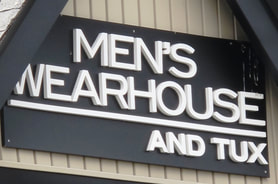 Image © by Brian E. Faulkner
Image © by Brian E. Faulkner Every brand, company, product or service has a story – just like people. People’s stories are a combination of image and reputation, which can be anything from well focused to wildly irresponsible. Some businesses may be well-positioned (in a controlled, strategic sense) while others cast their reputation to the wind, allowing the marketplace to define who they are and what they represent. Call it default positioning. The example that most often comes to my mind is Microsoft, which hasn’t done a great positioning job. There are many “Microsofts” out there, depending on who's doing the talking.
Heard an interview with George Zimmer on NPR this morning. His topic was paying people more, even at the expense of company profits. But what grabbed my attention was his distinctive gravelly voice, the one he used on television when he was boss of The Men’s Wearhouse – you know the one:
“You’re going to like the way you look. “I guarantee it!”
Every spot had a story, and as leader-spokesperson, Zimmer was deeply imbedded in the Men’s Wearhouse image -- along with that famous tagline. I can’t help but notice that the Men’s Wearhouse strategic positioning has become less distinctive since Zimmer was forced out, supposedly because of management disagreements. Something’s missing from their advertising, and it’s not just Zimmer. Despite the few recent Men’s Wearhouse spots featuring signature suit designer Joseph Abboud, their marketing seems focused more on price, like their long-time competitor, Jos. A. Bank, which Men’s Wearhouse purchased early in 2014 after a turbulent takeover battle.
The takeaway here is that a strong brand story should not be discarded so readily, although I’m sure the Men’s Warehouse board thought long and hard about the strategic consequences of dumping Zimmer. I find it discouraging, however, that they’ve fallen back on price advertising after such success with set-apart positioning, although it must be working or they wouldn’t do it. But I’ll bet their margins aren’t as good as when Zimmer was hawking the wares, because price was hardly mentioned in his spots and, as I recall, Wall Street liked the stock.
I have several friends and acquaintances, each with a business in the same retail category. Two of them ride a high-price wave supported by a brand story that's more than 150 years old. They don’t have to sell on price and, as a result, get high margins. Another friend sells the same type of high-end merchandise at market prices, although different brands. His business story has been established for well over 50 years; customers seek him out because of his quality reputation. Still others I know in that same business always seem to be wrestling with price. They don’t command the margins they could because their business stories are indistinct. They don’t have a Marketable Truth© to stand on.
Both Ford Motor Company and GM currently are wrestling with their image stories. GM is in the latter stages of rebooting its Cadillac brand to compete with the best German luxury performance sedans; they've had enough success that Cadillac is no longer seen as exclusively for oldsters seeking a luxury nameplate and plush ride. Buick, another GM brand that used to have a fuddy-duddy image, is experiencing a surprising sales renaissance driven by rising demand in China, where the brand has become a status symbol. Different time, different story.
Ford also is into a bit of image retooling of late. Lincoln (finally!) is thinking about abandoning its confusing alphabet soup model designations in favor of real names like Continental and possibly even Zephyr. All while Ford grapples with a negative quality blip brought about in recent years by a dashboard communication and entertainment system that has proven troublesome and hard to use – so much so that auto enthusiast Web sites are recommending that people wait ‘til a redesigned system comes out on the 2016 models later this year to purchase their new Fords and Lincolns.
When I think of brand image, however, I think most often about Apple. They were an upstart at first, but gradually built a business, operating system and reputation that out-shined the king of personal computers at that time, the venerable IBM. Will gutsy moves into new product categories like luxury watches and even automobiles sour Apple’s reputation? Not likely, because they’ve told and retold their brand story so well – and so long – that they’re as close to invincible as any business or brand out there.
Even so, in this day of social-driven media, there are new voices everywhere, and some percentage is quick to broadcast bad news. One exemplary misstep marketers are quick to recall is the New Coke debacle of 1985, when Coca-Cola almost lost its way -- and that was before the Internet became so widely available. This very day, April 29, 2015, online rumblings are afoot about a second brand of listeria-laden ice cream and a major beer maker’s label that seems to make light of rape.
Reputation or image -- call it what you will -- can bite you in the backside any minute … but also can help lead you to greatness. All the more reason to consider whether your brand, business, product or service is solidly positioned in today’s uber-competitive, uber-critical world.
TakeAway: Shape your strategic position carefully. And guard your brand story for dear life.
Content © by Brian E. Faulkner Marketable Truth © by Brian E. Faulkner

 RSS Feed
RSS Feed